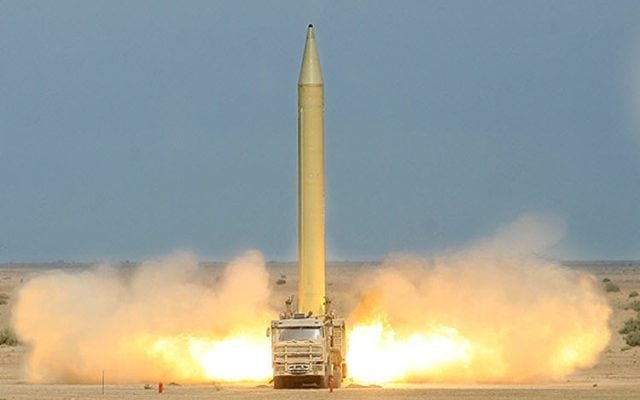Iran has conducted ballistic missile tests in violation of a UN resolution, while its secret testing grounds have been exposed.
By: Aryeh Savir, World Israel News and JNS
Israel’s Ambassador to the United Nations Danny Danon informed the Security Council (UNSC) on Thursday that Iran had conducted two ballistic missile tests in January, in direct violation of Resolution 2231.
“On 2 January 2018, Iran launched a SHAHAB 3 variant at the CHA-BAHAR (South East Iran) firing range. On 5 January 2018, Iran launched a Scud variant from a firing range 110 km North East of Kerman,” Danon revealed.
Both the SHAHAB 3 and Scud missiles are Missile Technology Control Regime (MTCR) category one ballistic missiles, capable of delivering a nuclear payload of 500 kilograms for a range of over 300 kilometers.
UN Security Council Resolution 2231, which endorsed the Iran nuclear agreement reached between Iran and the P5+1 powers (US, UK, France, Russia, China, and Germany), explicitly prohibits Iran from tests and other activity on ballistic missiles designed to be capable of delivering nuclear weapons.
“Iran’s activities, are therefore, in violation of Article 3 of Annex B to Security Council Resolution 2231.” Danon wrote to the Council.
Danon further charged that these launches are part of a series of “Iranian breaches of this resolution this year, including the missiles it fired from Syria into Israel and the armed UAV it launched from Syria into Israeli airspace.”
Danon was referring to an incident earlier this month in which Iran’s Quds forces launched a barrage of rockets at IDF bases on the Golan Heights in northern Israel, prompting an extensive IAF attack on dozens of Iranian targets in Syria, and to an Iranian attempt in February to breach Israeli airspace with an armed UAV.
“Iran continues to ignore its obligations to the international community and further destabilize the Middle East, particularly in Syria, Lebanon, Iraq, Yemen and the Gaza Strip. Its activities pose a direct threat to Israel and the entire region,” Danon stated, while urging the Security Council to “remain vigilant in the face of Iranian aggression.”
Iran’s secret missile-testing sire exposed
This dramatic disclosure comes just a day after a The New York Times revealed that the Islamic Republic is probably conducting long-range ballistic-missile testing at a remote and secret facility in a desert hundreds of miles east of Tehran.
“An analysis of structures and ground markings at the facility strongly suggests, though does not prove, that it is developing the technology for long-range missiles, the researchers say,” the Times reported.
The report is accompanied by satellite images from June exposing the new launch pads and testing grounds.
The existence of a long-range ballistic-missile program would likely ratchet up tensions with the US and possibly Europe, which is in range of the missiles being tested.
According to the report, researchers from the Middlebury Institute of International Studies, who were looking at a recent flurry of state media material on Gen. Hassan Tehrani Moghaddam—the lead scientist on Iran’s long-range missile program, who died in a 2011 explosion while testing them—discovered purported evidence that long-range missile development and testing was being carried out at a secretive military facility in Shahrud in a remote Iranian desert about 220 miles east of Tehran.
Moghaddam “oversaw the development of a secret, second, facility in the remote Iranian desert that, they say, is operating to this day,” the report said, quoting the researchers.
While many believed that missile testing at Shahrud had ceased in 2013, satellite images of the site showed a steady increase in the number of buildings there in the last few years.
Additionally, large marks on the desert floor seen in the satellite images appeared to be the result of rocket engine test-firings, while an analysis of the concrete stands that would hold the missile engines during the test-firings indicate that they held engines between 62 and 93 tons of thrust, consistent with long-range missiles.
Iran preparing for the future
The report noted that the five experts who reviewed the research material all agree that it likely indicated such work. But it also pointed out that “it is possible that the facility is developing only medium-range missiles, which Iran already possesses, or perhaps an unusually sophisticated space program.”
According to the report, “the country does not appear to be sprinting toward a long-range missile but preparing the ground in case Iranian leaders should one day deem that necessary.”
Commenting on the research while speaking to Army Radio on Thursday, David Schmerler, one of its authors, said that the test site in question had already been under scrutiny, but its use was unknown until now.
The five-member team conducted an encompassing research and were successful in completing the puzzle, he said
While the Iranian rocket program was initially launched for the purpose of Space research, it quickly adopted military attributes, Schmerler added.
Moghaddam, architect of Iran’s nuclear program, pushed to develop intercontinental ballistic missiles, he said.





